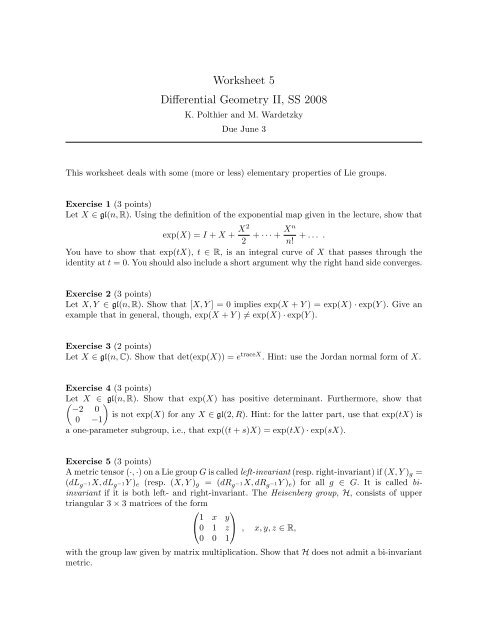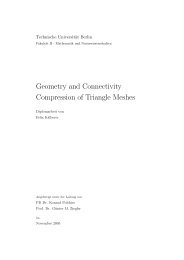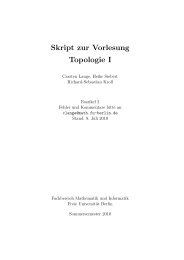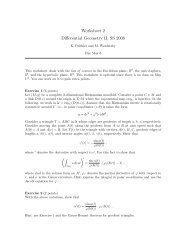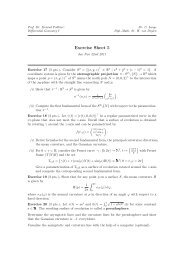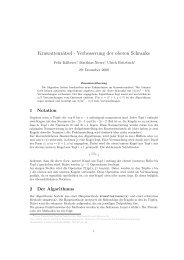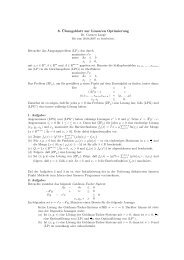Worksheet 5 Differential Geometry II, SS 2008
Worksheet 5 Differential Geometry II, SS 2008
Worksheet 5 Differential Geometry II, SS 2008
You also want an ePaper? Increase the reach of your titles
YUMPU automatically turns print PDFs into web optimized ePapers that Google loves.
<strong>Worksheet</strong> 5<br />
<strong>Differential</strong> <strong>Geometry</strong> <strong>II</strong>, <strong>SS</strong> <strong>2008</strong><br />
K. Polthier and M. Wardetzky<br />
Due June 3<br />
This worksheet deals with some (more or less) elementary properties of Lie groups.<br />
Exercise 1 (3 points)<br />
Let X ∈ gl(n, R). Using the definition of the exponential map given in the lecture, show that<br />
exp(X) = I + X + X2 Xn<br />
+ · · · + + . . . .<br />
2 n!<br />
You have to show that exp(tX), t ∈ R, is an integral curve of X that passes through the<br />
identity at t = 0. You should also include a short argument why the right hand side converges.<br />
Exercise 2 (3 points)<br />
Let X, Y ∈ gl(n, R). Show that [X, Y ] = 0 implies exp(X + Y ) = exp(X) · exp(Y ). Give an<br />
example that in general, though, exp(X + Y ) = exp(X) · exp(Y ).<br />
Exercise 3 (2 points)<br />
Let X ∈ gl(n, C). Show that det(exp(X)) = e traceX . Hint: use the Jordan normal form of X.<br />
Exercise 4 (3 points)<br />
Let X ∈gl(n, R). Show that exp(X) has positive determinant. Furthermore, show that<br />
−2 0<br />
is not exp(X) for any X ∈ gl(2, R). Hint: for the latter part, use that exp(tX) is<br />
0 −1<br />
a one-parameter subgroup, i.e., that exp((t + s)X) = exp(tX) · exp(sX).<br />
Exercise 5 (3 points)<br />
A metric tensor (·, ·) on a Lie group G is called left-invariant (resp. right-invariant) if (X, Y )g =<br />
(dLg−1X, dLg−1Y )e (resp. (X, Y )g = (dRg−1X, dRg−1Y )e) for all g ∈ G. It is called biinvariant<br />
if it is both left- and right-invariant. The Heisenberg group, H, consists of upper<br />
triangular 3 × 3 matrices of the form<br />
⎛<br />
1 x<br />
⎝0 1<br />
⎞<br />
y<br />
z⎠<br />
, x, y, z ∈ R,<br />
0 0 1<br />
with the group law given by matrix multiplication. Show that H does not admit a bi-invariant<br />
metric.
Exercise 6 (6 points)<br />
Assume that G is connected and that the metric tensor is left-invariant. Show that the following<br />
statements are equivalent:<br />
(1) (·, ·) is bi-invariant.<br />
(2) Adg acts by isometries on TeG ∼ = g for all g ∈ G.<br />
(3) adX is skew-adjoint, i.e., (adXY, Z)e + (Y, adXZ)e = 0 for all X, Y, Z ∈ g.<br />
(4) The covariant derivative induced by (·, ·) satisfies 2∇XY = [X, Y ] for all X, Y ∈ g.<br />
(5) The curves exp(tX) are geodesics for all X ∈ g.<br />
Hints: (1) =⇒ (2) is rather straightforward. To show (2) =⇒ (3), use that Ad exp(tX) is an<br />
isometry and differentiate with respect to t. To obtain (3) =⇒ (4), use the Koszul formula.<br />
To show (4) =⇒ (5), notice that ∇XX = 0. Vice-versa, use polarization to deduce that<br />
(5) =⇒ (4), and use the Leibnitz rule to show (4) =⇒ (3). To obtain (3) =⇒ (2), differentiate<br />
(Ad exp(tX)(Y ), Ad exp(tX)(Z)) to show that Adg is an isometry for all g in a neighborhood U<br />
of e and use that any element of G can be expressed as a finite product of elements of U.<br />
Finally, (2) =⇒ (1) is rather straightforward again.


